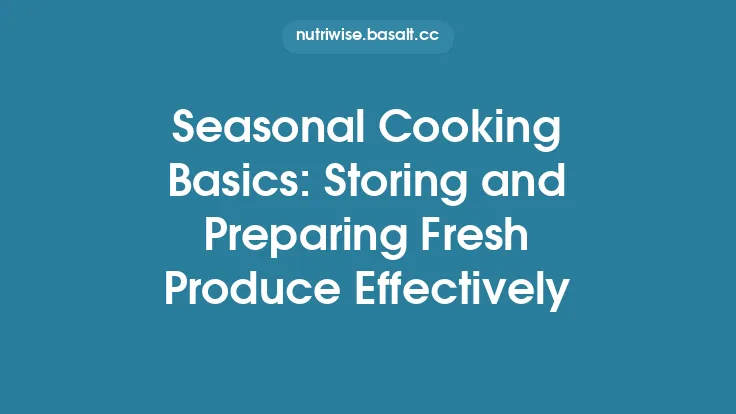Making your own condiments and sauces is one of the most effective, yet often overlooked, ways to stretch a grocery budget without sacrificing flavor. A pantry stocked with homemade ketchup, mayo, hot sauce, and dressings can replace a slew of pricey store‑bought jars, reduce packaging waste, and give you full control over ingredients—especially sodium, sugar, and preservatives. Below is a comprehensive guide that walks you through the why, the how, and the long‑term savings of DIY condiments, complete with cost analyses, essential tools, safety tips, and adaptable recipes that fit any cuisine.
Why Make Your Own Condiments?
1. Cost Savings
A single bottle of premium ketchup or artisanal hot sauce can cost $4–$7, while the raw ingredients for a comparable batch often total under $1. Over a year, swapping just three store‑bought jars for homemade versions can save $30–$50.
2. Ingredient Transparency
When you create sauces from scratch, you know exactly what’s inside—no hidden sugars, MSG, or artificial preservatives. This is especially valuable for families managing dietary restrictions or allergies.
3. Customizable Flavor Profiles
Homemade condiments let you tweak heat, sweetness, acidity, and herb intensity to match personal taste or the specific dish you’re preparing. A single base sauce can become a Mexican salsa, an Asian dipping sauce, or a Mediterranean vinaigrette with a few ingredient swaps.
4. Reduced Packaging Waste
Every jar you make at home replaces a plastic or glass container that would otherwise end up in the waste stream. Over time, this adds up to a noticeable environmental benefit.
Cost Comparison: Store‑Bought vs. Homemade
| Condiment | Avg. Store Price (16 oz) | Approx. Homemade Cost (16 oz) | Savings per Batch |
|---|---|---|---|
| Ketchup | $3.50 | $0.80 (tomatoes, vinegar, sugar) | $2.70 |
| Mayonnaise | $4.00 | $1.20 (egg yolks, oil, lemon) | $2.80 |
| BBQ Sauce | $4.50 | $1.00 (ketchup, molasses, spices) | $3.50 |
| Hot Sauce | $5.00 | $0.70 (chili peppers, vinegar) | $4.30 |
| Salad Dressing (Ranch) | $3.00 | $0.90 (buttermilk, herbs, mayo) | $2.10 |
| Soy‑Based Marinade | $4.00 | $1.10 (soy sauce, ginger, garlic) | $2.90 |
*Numbers are based on average U.S. grocery prices (2024) and assume bulk purchase of base ingredients.*
Essential Tools and Ingredients
Core Equipment
- Immersion Blender – Ideal for emulsifying dressings and sauces quickly.
- Food‑Scale – Precision matters for emulsions (e.g., mayo) and for cost tracking.
- Glass Jars with Lids – 8‑oz, 16‑oz, and 32‑oz sizes work well for storage and reuse.
- Saucepan & Cast‑Iron Skillet – For reducing sauces and caramelizing sugars.
- Fine‑Mesh Strainer – Removes seeds, skins, or pulp for smooth textures.
- pH Strips (optional) – Useful for high‑acid sauces (hot sauce, pickles) to ensure safety.
Staple Pantry Items
| Category | Typical Shelf Life | Example Uses |
|---|---|---|
| Vinegars (apple cider, white, rice) | 2–3 years | Acid base for ketchup, hot sauce, dressings |
| Sweeteners (sugar, honey, maple syrup) | Indefinite (dry) | Balance acidity, add body |
| Oils (vegetable, olive, avocado) | 1–2 years (refrigerated) | Emulsion carrier for mayo, pesto |
| Spices & Herbs (dried) | 2–4 years | Flavor foundation for BBQ, marinades |
| Tomato Products (paste, crushed) | 1 year (canned) | Base for ketchup, marinara |
| Chili Peppers (fresh, dried, flakes) | Fresh: 1 week; Dried: 1 year | Heat for hot sauce, salsas |
| Mustard Seeds & Powder | 2–3 years | Tang for dressings, sauces |
Investing in a small bulk container of each staple (e.g., a 5‑lb bag of sugar, a 2‑qt bottle of apple cider vinegar) reduces per‑use cost dramatically.
Basic Techniques for Homemade Sauces
1. Emulsification
An emulsion is a stable mixture of two immiscible liquids (oil and water). Classic examples are mayonnaise and vinaigrette. The key steps:
- Start with a base (egg yolk for mayo, mustard for vinaigrette) to act as an emulsifier.
- Add oil slowly while whisking or blending continuously. A 1:1 ratio of oil to base is a good starting point; adjust to desired thickness.
- Season and adjust acidity at the end to avoid breaking the emulsion.
2. Reduction
Simmering a sauce to evaporate water concentrates flavors and thickens texture. For ketchup or BBQ sauce:
- Combine all ingredients in a saucepan.
- Bring to a gentle boil, then lower to a simmer.
- Stir occasionally; watch for scorching.
- Reduce until the desired consistency (usually 1/3 to 1/2 of original volume).
3. Fermentation (Optional)
Fermented hot sauces develop depth and probiotic benefits. Basic method:
- Blend fresh chilies with salt (2 % of total weight).
- Pack into a sterilized jar, leaving headspace.
- Store at room temperature (65–75 °F) for 5–14 days, shaking daily.
- After fermentation, blend with vinegar and strain.
4. Infusion
Herb‑infused oils or vinegars add complexity without extra steps. Warm the oil/vinegar gently with herbs for 10–15 minutes, then cool and strain. Store in the refrigerator for up to 2 months.
Staple Condiment Recipes
Below are five foundational recipes that can be scaled up or down. All cost calculations assume bulk‑purchased base ingredients.
1. Classic Tomato Ketchup (16 oz)
Ingredients
- 2 cups tomato paste ($0.60)
- 1 cup apple cider vinegar ($0.20)
- ½ cup brown sugar ($0.15)
- ¼ cup water
- 1 tsp salt
- ½ tsp onion powder
- ½ tsp garlic powder
- ¼ tsp allspice
- Pinch of cinnamon
Method
- Whisk tomato paste, vinegar, sugar, and water in a saucepan.
- Add spices; bring to a low boil.
- Reduce heat; simmer 20 minutes, stirring frequently.
- Blend for a smooth texture; cool and transfer to a sterilized jar.
Cost per 16 oz: ≈ $0.80
Shelf life: 3 months refrigerated.
2. Homemade Mayonnaise (12 oz)
Ingredients
- 2 large egg yolks (room temperature) ($0.30)
- 1 tbsp Dijon mustard ($0.05)
- 1 tbsp lemon juice ($0.05)
- 1 tsp salt
- 1 cup neutral oil (vegetable or canola) ($0.70)
- Optional: ½ tsp white pepper
Method
- In a bowl, whisk yolks, mustard, lemon juice, and salt.
- Slowly drizzle oil while whisking vigorously (or use an immersion blender on low).
- Continue until thick and glossy; season to taste.
- Store in a clean glass jar.
Cost per 12 oz: ≈ $1.20
Shelf life: 2 weeks refrigerated (keep cold, use clean utensils).
3. Basic BBQ Sauce (16 oz)
Ingredients
- 1 cup ketchup (store‑bought or homemade) ($0.80)
- ¼ cup apple cider vinegar ($0.10)
- ¼ cup molasses ($0.20)
- 2 tbsp brown sugar ($0.05)
- 1 tbsp Worcestershire sauce ($0.10)
- 1 tsp smoked paprika
- ½ tsp garlic powder
- ½ tsp onion powder
- ¼ tsp cayenne (optional)
Method
- Combine all ingredients in a saucepan.
- Simmer 15 minutes, stirring occasionally, until thickened.
- Cool and bottle.
Cost per 16 oz: ≈ $1.00
Shelf life: 1 month refrigerated.
4. Simple Hot Sauce (8 oz)
Ingredients
- 10 oz fresh red chilies (e.g., jalapeño, serrano) ($0.70)
- ½ cup white vinegar ($0.10)
- 1 tsp salt
- 1 tbsp sugar (optional)
Method
- Remove stems; roughly chop chilies (keep seeds for extra heat).
- Blend chilies, vinegar, salt, and sugar until smooth.
- Transfer to a saucepan; bring to a boil, then simmer 5 minutes.
- Strain for a smoother sauce or leave pulpy.
- Bottle and refrigerate.
Cost per 8 oz: ≈ $0.80
Shelf life: 3 months refrigerated.
5. Versatile Herb Vinaigrette (12 oz)
Ingredients
- ¼ cup extra‑virgin olive oil ($0.40)
- 2 tbsp red wine vinegar ($0.05)
- 1 tsp Dijon mustard ($0.05)
- 1 tsp honey or maple syrup ($0.05)
- 1 tbsp finely chopped fresh herbs (parsley, basil, or dill) ($0.10)
- Salt & pepper to taste
Method
- Whisk mustard, vinegar, honey, and herbs together.
- Slowly drizzle oil while whisking to emulsify.
- Season; store in a sealed jar.
Cost per 12 oz: ≈ $0.65
Shelf life: 2 weeks refrigerated.
Batch‑Cooking and Freezing Sauces
Many sauces improve after a day of melding flavors, making them perfect candidates for batch preparation.
| Sauce | Freezable? | Recommended Freezing Method | Thawing |
|---|---|---|---|
| Ketchup | Yes | Portion into ½‑cup freezer bags; label with date. | Thaw in refrigerator 12 h; stir before use. |
| Mayonnaise | No (emulsion breaks) | Instead, freeze the *ingredients* (egg yolks, oil) separately and recombine fresh when needed. | |
| BBQ Sauce | Yes | Freeze in silicone ice‑cube trays, then transfer cubes to a zip‑top bag. | Thaw in microwave or stovetop; re‑heat gently. |
| Hot Sauce | Yes | Store in sterilized glass jars; keep in freezer for up to 6 months. | Thaw at room temperature; shake before using. |
| Herb Vinaigrette | Yes (if oil‑based) | Freeze in small containers; add fresh herbs after thawing for brightness. | Thaw in refrigerator; whisk before serving. |
Tip: Adding a teaspoon of lemon juice or vinegar to a sauce before freezing can help preserve color and flavor.
Flavor Boosters and Customization
Once you have a base sauce, a handful of pantry staples can transform it:
- Umami Enhancers: A splash of soy sauce, miso paste, or Worcestershire adds depth to BBQ or ketchup.
- Sweet Balance: A pinch of brown sugar, maple syrup, or fruit puree (e.g., mango for hot sauce) rounds out acidity.
- Heat Variations: Swap fresh chilies for smoked chipotle, or add a dash of cayenne, Sriracha, or harissa.
- Herb & Spice Swaps: Replace dried oregano with fresh thyme in vinaigrette, or add ground cumin to BBQ for a Mexican twist.
- Texture Play: Blend in roasted nuts (e.g., peanuts for satay sauce) or seeds (sesame for tahini‑based dressings).
By keeping a small “flavor pantry” of these boosters, you can repurpose a single batch of sauce into multiple variations, further extending your savings.
Food Safety and Shelf Life
pH Matters
Acidic sauces (pH ≤ 4.6) such as hot sauce and ketchup are naturally resistant to botulism. Use a calibrated pH meter or test strips to confirm acidity, especially when fermenting.
Sterilizing Jars
- Boiling Water Method: Submerge jars and lids in a large pot of water; boil for 10 minutes.
- Oven Method: Place clean jars (no lids) on a baking sheet; heat at 275 °F for 15 minutes.
Refrigeration Guidelines
- Store all homemade condiments in the refrigerator unless the recipe includes a high acid level and proper canning process.
- Label each jar with the production date; use a “first‑in, first‑out” system.
Signs of Spoilage
- Off‑odor (sour, rancid, or fermented beyond expectation)
- Mold growth on the surface or lid
- Unusual texture (separation that won’t re‑emulsify after vigorous shaking)
When in doubt, discard. The cost of a jar is far less than the risk of foodborne illness.
Storing and Organizing Your DIY Condiment Kitchen
- Designate a Shelf: Reserve a single refrigerator door shelf for all homemade sauces. This keeps them visible and reduces the chance of forgetting about older jars.
- Use Uniform Containers: Clear glass jars with wide mouths make it easy to see contents and facilitate cleaning.
- Label System: Include the name, date, and “best by” on each label. Colored stickers (e.g., green for dressings, red for hot sauces) provide quick visual cues.
- Inventory Sheet: Keep a small notebook or spreadsheet tracking quantities on hand, production dates, and upcoming expiration dates. This helps you plan meals around what you already have, minimizing waste.
Tips for Reducing Waste and Maximizing Savings
- Utilize Scraps: Blend carrot tops, beet greens, or herb stems into pesto or vinaigrette bases.
- Make Small Batches First: If you’re new to DIY sauces, start with 8‑oz batches to gauge flavor preferences before scaling up.
- Buy in Bulk, Portion Out: Purchase large bags of sugar, salt, and dried spices; portion them into smaller containers to avoid moisture exposure.
- Swap Ingredients Across Recipes: Use leftover tomato paste from ketchup to enrich a marinara sauce, or repurpose excess vinegar from hot sauce for pickling vegetables.
- Rotate Seasonal Produce: Adjust hot sauce heat level based on the season’s available chilies (e.g., milder peppers in summer, hotter varieties in fall).
Putting It All Together: Integrating Homemade Condiments into Meal Planning
- Plan a “Condiment Day” each week where you batch‑make two or three sauces. This aligns with the broader weekly meal‑prep routine without adding extra grocery trips.
- Pair Sauces with Core Proteins: Store‑bought sauces often dictate the protein choice (e.g., “BBQ chicken”). With homemade sauces, you can pair the same sauce with beans, tofu, pork, or fish, expanding menu variety.
- Use Sauces as Flavor Anchors: A drizzle of homemade hot sauce can turn a simple scrambled egg into a breakfast‑bowl highlight, while a spoonful of pesto can elevate a plain pasta to a restaurant‑level dish.
- Track Savings: Keep a simple log of how many store‑bought jars you avoided each month and the corresponding cost. Seeing the numbers reinforces the habit.
By mastering a handful of core techniques, stocking a modest “condiment pantry,” and applying systematic storage practices, you can dramatically cut grocery expenses while enriching every meal with fresh, personalized flavor. The upfront time investment pays off quickly—both in dollars saved and in the satisfaction of knowing exactly what’s on your plate. Happy sauce‑making!





